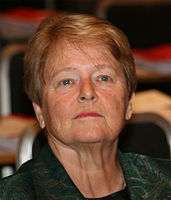Prime Minister of Norway
- This is a descriptive article. For a list, see List of heads of government of Norway.
| Prime Minister of Norway
Norsk statsminister | |
|---|---|
 | |
| Style | Her Excellency (informal) |
| Residence | Inkognitogata 18 |
| Seat |
Office of the Prime Minister at: |
| Appointer | The Monarch |
| Term length |
No term limits General elections are held every four years. The Prime Minister is by convention the leader of the party with majority support in Parliament. |
| Inaugural holder | Frederik Stang (generally regarded as the first incumbent) |
| Formation | 1873 |
| Website | Government Official Homepage |
 |
|---|
| This article is part of a series on the politics and government of Norway |
| Constitution |
|
Government |
|
Parliament
|
The Prime Minister of Norway (Norwegian: statsminister, literally the "minister of the state") is the head of government of Norway and the most powerful person in Norwegian politics. The Prime Minister and Cabinet (consisting of all the most senior government department heads) are collectively accountable for their policies and actions to the Monarch, to the Storting (Parliament of Norway), to their political party, and ultimately the electorate. In practice, since it is nearly impossible for a government to stay in office against the will of the Storting, the Prime Minister is primarily answerable to the Storting. He or she is almost always the leader of the majority party in the Storting, or the leader of the senior partner in the governing coalition.
Norway has a Constitution, which was adopted on 17 May 1814.[1] The position of Prime Minister is the result of legislation. Modern Prime Ministers have few statutory powers, but provided they can command the support of their parliamentary party, they can control both the legislature and the executive (the Cabinet) and hence wield considerable de facto powers. As of 2018, the Prime Minister of Norway is Erna Solberg, of the Conservative Party.
Unlike their counterparts in the rest of Europe, Norwegian Prime Ministers do not have the option of advising the King to dissolve the Storting and call a snap election. The Constitution requires that the Storting serve out its full four-year term. If the Prime Minister loses the confidence of the Storting, he or she must resign.
Longest-sitting Prime Ministers
| Nr. | Prime Minister | Party | Days | Years, months, days |
|---|---|---|---|---|
| 1. | Einar Gerhardsen | Labour Party | 6226 | 17 years and 17 days |
| 2. | Johan Nygaardsvold | Labour Party | 3750 | 10 years, 3 months and 5 days |
| 3. | Gro Harlem Brundtland | Labour Party | 3691 | 10 years, 1 month and 9 days |
| 4. | Jens Stoltenberg | Labour Party | 3518 | 9 years, 7 months and 17 days |
| 5. | Gunnar Knudsen | Liberal Party | 3383 | 9 years, 3 months and 4 days |
| 6. | Johan Ludwig Mowinckel | Liberal Party | 2517 | 6 years, 10 months and 21 days |
| 7. | Kjell Magne Bondevik | Christian Democratic Party | 2341 | 6 years, 4 months and 29 days |
| 8. | Johannes Steen | Liberal Party | 2311 | 6 years, 3 months and 30 days |
| 9. | Per Borten | Centre Party | 1982 | 5 years, 5 months and 5 days |
| 10. | Odvar Nordli | Labour Party | 1847 | 5 years and 20 days |
Living former Prime Ministers
As of 2018 five former Prime Ministers are alive:
- Living former Prime Ministers



.png)
See also
References
- ↑ "NORWAY'S STRUGGLE WITH HER KING" (PDF). The New York Times. 11 November 1882. Retrieved 3 February 2009.
.jpg)